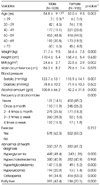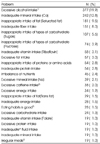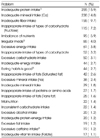Abstract
Objectives
This study was performed to examine nutrition problems and causes/contributing risk factors.
Methods
This study was conducted using data 1,863 adults visited Asan health screening & promotion center located in Seoul, Korea during May to June of 2013. We used Nutrition Care Process Model developed by the International Dietetics & Nutrition Terminology (IDNT).
Results
The most frequent nutrition problem in male subjects was excessive alcohol intake. Men in fifties showed the highest rate of excessive alcohol intake among the age groups examined (22.4%). By comparison, the most frequent nutrition problem in women was inadequate protein intake. Women in fifties exhibited the highest rate of inadequate protein intake (22.5%). The most common contributing factors for these observations were a low preference for dairy products followed by high preference for alcohol and a deficit in food-and nutrition-related knowledge, regardless of the sex and age. The most common nutrition problem observed among the group diagnosed with hyperglycemia or hypertriglyceridemia or hyperuricemia or fatty liver was excessive alcohol intake (p<0.001), whereas the group diagnosed with hyperglycemia or hypercholesterolemia showed significantly higher rate of inappropriate intake of carbohydrate (fructose) compared to the group not diagnosed with such disease conditions (p<0.05). The group diagnosed with hypercholesterolemia, hyperuricemia and fatty liver showed significantly higher occurrence of inappropriate intake of fat (saturated fat) than the group free of such diseases (p< 0.001). The osteopenia group showed higher rate of inadequate protein intake (p<0.001) and the fatty liver group with excessive energy intake (p<0.001). Overall, the results suggest that there is a significant relationship between nutrition problems and health conditions found in groups diagnosed with a diverse array of medical conditions.
Figures and Tables
References
1. American Dietetic Association. Nutrition diagnosis: A critical step in the nutrition Care Process. Chicago: American Dietetic Association;2006. p. 1–12.
2. Asrih M, Jornayvaz FR. Diets and nonalcoholic fatty liver disease: The good and the bad. Clin Nutr. 2014; 33(2):186–190.
3. Choi MK, Bae YJ. A study on blood lipids and blood pressure of adult men and women according to vegetable intake. Korean J Community Nutr. 2007; 12(6):761–772.
4. Chung CE. Association of total sugar intakes and metabolic syndrome from Korean national health and nutrition examination survey 2001-2002. Korean J Nutr. 2007; 40(Suppl):29–38.
5. Franz MJ, Boucher JL, Green-Pastors J, Powers MA. Evidence-based nutrition practice guidelines for diabets and scope and standards of practice. J Am Diet Assoc. 2008; 108(4):S52–S58.
6. Havel PJ. Dietary fructose: Implications for dysregulation of energy homeostasis and lipid/carbohydrate metabolism. Nutr Rev. 2005; 63(5):133–157.
7. Jun DW. The role of diet in non-alcoholic fatty liver disease. Korean J Gastroenterol. 2013; 61(5):243–251.
8. Kim K, Yun SH, Choi BY, Kim MK. Cross-sectional relationship between dietary carbohydrate, glycaemic index, glycaemic load and risk of the metabolic syndrome in a Korean population. Br J Nutr. 2008; 100(3):576–584.
9. Kim YH. Analysis of estimated dietary fiber intake of Korean during the 2000s. MS thesis. Kyungpook National University;2011. 112.
10. Korea Consumer Agency. Excessive intake of sugars and caffeine. 2014. cited July 9, 2014. Available from http://www.ftc.go.kr/policy/consumer/competView4.jsp?report_data_no=5721&tribu_type_cd=000002&report_data_div_cd=&currpage=1&searchKey=&searchVal=&stdat e=&enddate.
11. Korean Nutrition Society. Dietary reference intakes for Koreans. Seoul: Korean Nutrition Society;2010.
12. Lacey K, Pritchett E. Nutrition care process and model: ADA adopts road map to quality care and outcomes management. J Am Diet Assoc. 2003; 103(8):1061–1072.
13. Lee GJ. Nutrition Care Process and Diabetes: Focus on Nutrition Diagnosis. J Korean Diabetes. 2012; 13(1):48–51.
14. Lee SH. Association of bone mineral density with dietary intake and health-related behavior among Korean postmenopausal women. Dissertation. Myong-ji Univerity;2012. 25–76.
15. Lim KS, Lee TY, Kang YH, Kim JH, Kim CI, Jang KJ, Kim KY, Lee HJ, Park SJ, Choi HM. Analysis of dietary fat intake according to health related factors in adults aged 50 years and over in Korea. Korean J Health Promot Dis Prev. 2004; 4(1):25–37.
16. McNamara DJ. Dietary cholesterol and optimal diet for reducing risk of atherosclerosis. Can J Cardiol. 1995; 11(suppl):123–126.
17. Moon HK, Kong JE. Assessment of nutrient intake for middle aged with and without metabolic syndrome using 2005 and 2007 Korean National Health and Nutrition Survey. Korean J Nutr. 2010; 43(1):69–78.
18. Mun SO, Kim JH, Yang YJ. Factors associated with bone mineral density in Korean postmenopausal women aged 50 years and above: Using 2008-2010 Korean national health and nutrition examination survey. Korean J Community Nutr. 2013; 18(2):177–186.
19. Oh SW. Effects of Alcohol on Obesity and Metabolic Syndrome. Korean J Obes. 2009; 18(1):1–7.
20. Oh SY, Shin MH, Lee SH, Kim JE, Lee HS, Cho JS, Kim HY. The development of food frequency Questionnaire for nutrition assessment in adults. In : Proceedings of 2007 conference of the Korean Society of Health Promotion; 2007. p. 67–72.
21. American Dietetic Association.
SM Lee
EM Kim
WK Kim
MS Park
MA Park
HJ Baek
KJ Lee
E Lee
HS Lee
YY Cho
. International dietetics & nutrition terminology(INDT) Reference manual, Standardized language for the nutrition care process. -2nd ed-(translated version). 2011. p. 13–354.
22. World Health Organization. WHO opens public consultation on draft sugars guideline. 2014. cited March 5, 2014. Available from http://www.who.int/mediacentre/news/notes/2014/consultation-sugar-guideline/en/.
23. Yasutake K, Kohjima M, Kotoh K, Nakashima M, Nakamuta M, Enjoji M. Dietary habits and behaviors associated with nonalcoholic fatty liver disease. World J Gastroenterol. 2014; 20(7):1756–1767.
24. Yu CH, Lee JS, Lee IH, Kim SH, Lee SS, Kang SA. Nutritional factors related to bone mineral density in the different age groups of Korean men. Korean J Nutr. 2014; 37(2):132–142.




 PDF
PDF ePub
ePub Citation
Citation Print
Print









 XML Download
XML Download